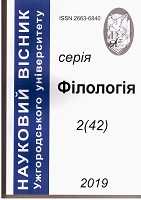LEXICAL UNITS DENOTING PARALANGUAGE ELEMENTS OF COMMUNICATION
DOI:
https://doi.org/10.24144/2663-6840.2019.2.(42).56-61Ключові слова:
paralanguage, lexeme, acoustic properties, shouting, crying, laughing, component, voiceАнотація
Nonverbal communication is the process of sending and receiving messages between two or more people without the use of words. We can communicate in a variety of nonverbal ways including our posture, gestures, facial expressions, touch, eye contact, and intonation. Research suggests that nonverbal communication makes up over 60-70% of all that we communicate. In other words, how we say something is often more important than what we say.Paralanguage is considered to be one of the components of non-verbal communication, which goes beyond the specific spoken words. It includes pitch, amplitude, rate, and voice quality of speech. Paralanguage reminds us that people convey their feelings not only in what they say, but also in how they say it.
The present research paper is devoted to the study of the verbalization of paralanguage as the component of non-verbal communication in English.The topicality of the paper is preconditioned by the general orientation of modern linguistics on the analysis of the ways and means a language possesses for the nomination of different properties of speech which, in their turn, proved to be an important means of non-verbal communication. The aimof the research is to provide an analysis of language units, used for the nomination of paralanguage components of communication in Modern English. The subject of the inves- tigation is represented by the analysis of language units used for the verbilazation of paralanguage elements. The object of the research is lexical units verbalizing paralanguage components of non-verbal communication in Modern English. Primary attention is focused on the analyses of the lexemes representing different properties of the voice. As far as paralanguage con- siders the acoustic properties of the voice, we have considered the functioning of the lexemes, which in combination with the adverbs also demonstrate a variety of feelings and emotions of the speakers. We have also fixed lexical units used to verbalize shouting, crying, laughing.The acoustic aspect of voice found the reflection in such units as: to grumble, to murmur, to sniff, to twang etc. In the course of the analysis we have also fixed lexical units used for the nomination even of the absence of speech. Being the component of paralanguage silence finds its manifestation in a number of lexical units, each of which demonstrates certain functional characteristics.
Посилання
Антипова А. М. О взаимодействии вербальных и невербальных средств общения в спонтанной разговорной речи. Проблемы спонтанной разговорной речи. Вып. 332. 1989. С.61–75.
Birdwhistell R.L. The language of the body: The Natural Environment of Words. Human Communication: Theory Exploration. N.Y.: Hillsdale, 2013. 220 p.
Bolinger P. Intonation and Gesture. American Speech, vol. 58, 1983. Р. 150–113.
Boyle E. The Effects of Visibility on Dialogue and Performance in a Cooperative Problem Solving Task. Language. Speech, vol.37, 1994. Р. 1–20.
Collins English Dictionary [online]. Available from: http://www.collinsdictionary.com/dictionary/
Ekman P. Hand Movements. Journal of Communication. 1994. № 22. Р. 313–353.
Goddard R. Caught in the Light. London: Corgi Books, 2003. 245 p.
Greeley A. Patience of a saint. New York: Warner Books, 2006. 229 p.
Колшанский Г. Паралингвистика. Москва: Наука, 1973. 96 c.
Конецкая В.П. Социология коммуникации. Москва: Международный университет бизнеса и управления. 1997. 304 с.
Крейдлин Г.Е. Невербальная семиотика: [Язык тела и естественный язык]. Москва: Новое литературное обозрение, 2004. 581 с.
Миккин Х.Х. Роль коммуникативных движений в межличностном общении. Москва: Наука, 1977. 210 с.
Random House Kernerman Webster’s College Dictionary [online]. Available from: http://www. kdictionaries-online.com/
Шевченко О.І. Невербальні компоненти комунікації в антропоцентричній науковій парадигмі. Актуальні проблеми гуманітарного пізнання. Вип. 6. 2004. С. 59–66.
The Concise Oxford Dictionary of Linguistics [2007] [ed. Peter Hugoe Matthews]. – Oxford: OUP, 2007. 443 p.
The Free Thesaurus [online]. Available from: www.freethesaurus.com.
The New Oxford Dictionary of English [ed. J. Pearsall]. Oxford: Clarendon Press, 1998. 2152 p.
Trager L. Paralanguage: A First Approximation. Studies in Linguistics. № 2. 1958. p. 1–12.
Woods S. Ask anyone. London: Harlequin Books. 2003.

